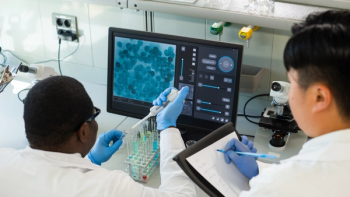
Using AI to Create New Parkinson’s Treatments: Q&A with Matthias Alder
Alder, CEO of Gain Therapeutics, discusses how the Magellan platform was used in the creation of GT-02287.
Gain Therapeutics is in the clinical trials phase for a new Parkinson’s treatment known as GT-02287, which may be able to prevent symptoms from worsening or even occurring. The company’s CEO, Matthias Alder, spoke with Pharmaceutical Executive about the drug and how an AI-powered platform was used to develop it.
PE: Can you discuss the GT-02287 study and the results?
Matthias Alder: When I joined the company about two-and-a-half years ago, we had just received data from patient-derived cells which showed that the drug has an effect in terms of actually restoring critical enzymes in terms of cell survival. Since then, we’ve moved all the way through the research and pre-clinical stages and are now in the clinic with the drugs. It’s a phase 1 clinical trial that’s currently going. It’s populated with healthy volunteers because we’re looking at Parkinson’s Disease as our lead indication. Because neurodegeneration is different from oncology, we need to look at healthy volunteers first.
We’re in the process of finishing up the phase 1 study of healthy volunteers. It should finish up towards the second half of Q2 this year. At which point, we will have established the safety and tolerability of the drug in humans. Then we plan to expand this study and add a patient cohort of Parkinson’s patients, who we plan to treat for three months.
We’ll be looking at the effects of this drug on biomarkers related to the effects of Parkinson’s and the disease cascade that we’re specifically addressing with our mechanism of action.
PE: How important is this treatment for Parkinson’s research in general?
Alder: It’s hugely important in terms of what we’re doing because right now, in terms of Parkinson’s disease, the only therapies that are available are symptomatic treatments. As Parkinson’s develops, you have a certain type of brain cell that produces dopamine, and these cells that sit in the part of the brain that controls movement. If these neurons die, the dopamine levels drop, and the neurotransmitter is missing. At this point, patients start developing the symptoms: tremors, lack of balance, and rigidity of muscles. Things that relate to motor control.
Right now, the treatments that are available are stimulating dopamine production from whatever neurons are still present. Other treatments replace dopamine artificially. Eventually, all of these treatments only manage the symptoms for a period of time and these patients fall off the wagon on the back end of the disease. Our current treatments stop working and the patients become completely disabilitated. They cannot feed themselves anymore, they have difficulty swallowing, and they start to develop cognitive issues.
We’re working on something very different. We’re not trying to manage symptoms, what we’re planning to do is to stop the death of the dopamine producing brain cells. By protecting these cells from death, we can actually slow or even stop the progression of the disease. This is important in thinking about how the diagnosis of the disease has evolved.
Up until very recently, diagnosis of Parkinson’s was done solely on symptoms. That is starting to change. The problem is that once you have symptoms, maybe 80% of the dopamine-producing neurons have died. There’s not as much that can be protected by a drug that prevents cell death.
Once the drug gets approved, the really interesting test will be on pre-symptomatic patients who still have loads of dopamine producing neurons alive and working. The test will be if we can protect them from dying off and allows extends the patients’ symptom free life, or even stopping the symptoms from occurring altogether. Essentially, they could live a healthy life as opposed to what they’d struggle with in the absence of our treatment.
PE: Can you discuss how the MAGELLAN platform was used?
Alder: The MAGELLAN platform combines AI-methods with physics-based methods to identify novel binding sites of drugs. We’re finding these novel bonding sites by just scanning the surface. These pockets couldn’t be seen before. Once we’ve found these pockets with the platform, we can screen the virtual libraries that are available from a range of different sources to find the best molecule that binds into that pocket to have the effect of either restoring the function of the protein or disrupting the function of a protein (which is typically what you’d want to do in cancer indications).
It's a versatile platform, we’ve used it to generate the entirety of our product pipeline. The interesting thing about the platform is that it removes the serendipity from the drug discovery process. We can be very specific since we know the binding pocket and what kind of small molecule we need to develop. We can be very specific in terms of how we find these molecules and it gives us the opportunity to best-in-class and first-in-class treatments.
Newsletter
Lead with insight with the Pharmaceutical Executive newsletter, featuring strategic analysis, leadership trends, and market intelligence for biopharma decision-makers.




